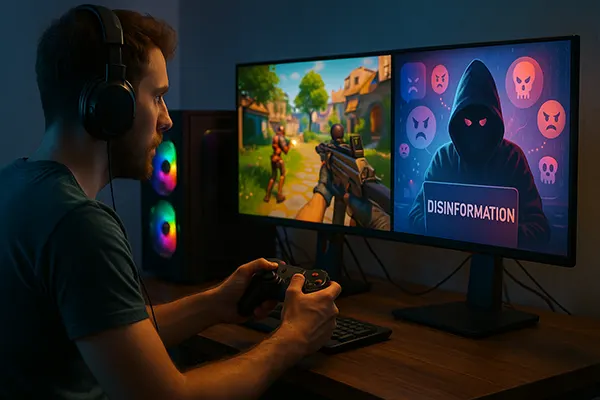Gamification of Disinformation: How Video Games and Streams Became New Channels of Influence

Disinformation has always evolved alongside technological progress, adapting to the communication channels most popular among society. By 2025, the gaming industry and live streaming have become powerful ecosystems not only for entertainment but also for spreading narratives that can shape opinions, reinforce stereotypes, and even influence political processes. The interactive nature of games, combined with the real-time engagement of streams, makes them especially attractive tools for those aiming to distribute manipulative content.
The Rise of Gaming as an Information Channel
Over the past decade, video games have transformed from individual entertainment products into complex social spaces. Games such as Fortnite, Minecraft, and Roblox have created virtual environments where millions of players interact daily. These interactions are not limited to gameplay mechanics – they include communication, exchange of ideas, and the consumption of cultural references. This evolution has turned games into arenas where narratives can be embedded subtly, through storytelling, character representation, or even user-generated content.
The global scale of the gaming industry further amplifies this influence. According to market analysis in 2025, over 3.5 billion people worldwide are active gamers. This massive audience creates a fertile ground for messages that can spread quickly and bypass traditional fact-checking filters. Unlike news or social media, where misinformation is more likely to be scrutinised, in games the immersive context often masks ideological undertones.
Governments and organisations are increasingly aware of this potential. Some studies highlight how state-backed groups experiment with in-game propaganda, embedding historical revisionism or political symbols into mods, maps, or community-created levels. These strategies resemble the ways in which film and television were once used for cultural influence, but adapted for a more interactive generation.
Mechanics of Gamified Disinformation
The effectiveness of gaming as a channel for disinformation lies in the mechanics of gamification itself. Players are rewarded for achieving objectives, making decisions, or repeating certain behaviours. When these mechanics are linked to ideological content, they reinforce specific values or narratives through positive reinforcement. For instance, completing missions that glorify particular historical events or demonise specific groups can subtly shape perceptions over time.
Multiplayer environments enhance this effect, as peer validation within gaming communities often outweighs critical assessment. Players tend to trust narratives endorsed by their peers, creating echo chambers where misinformation spreads rapidly. Combined with anonymity and global connectivity, this makes games an ideal testing ground for narratives designed to normalise certain viewpoints.
Such approaches are not always deliberate manipulations by developers. Community-generated modifications can introduce content that blurs the line between harmless creativity and ideological indoctrination. Moderation challenges remain immense, especially in games with user-created ecosystems.
The Role of Live Streaming in Amplifying Narratives
Parallel to the rise of gaming, live streaming has become one of the most influential media formats of the 2020s. Platforms such as Twitch, YouTube Gaming, and Kick attract millions of daily viewers who watch their favourite creators in real time. The personal nature of this interaction creates a sense of trust between streamer and audience, often stronger than traditional media relationships.
This dynamic gives streamers extraordinary power to shape opinions. When influential figures discuss politics, social issues, or cultural topics during streams, their words reach global audiences instantly. If combined with gaming content that already carries ideological undertones, the result is a potent tool for disinformation. In some cases, disinformation campaigns exploit popular streamers, either through sponsorship, coercion, or manipulation of trending topics.
Unlike edited videos or articles, live streams are challenging to monitor in real time. This allows misinformation to circulate before any fact-checking or platform intervention can occur. In an era when younger generations spend more time watching streams than traditional television, the implications for democratic discourse and public trust are significant.
Community Engagement and Viral Spread
The interactivity of streams is a critical factor. Live chats, donations, and interactive polls create a feedback loop where audience participation amplifies certain narratives. This makes it easy for disinformation to gain traction, as controversial or provocative statements often attract more engagement than neutral discussions. Algorithms that promote high-engagement content further intensify this cycle.
Memes, clips, and highlights extracted from live streams circulate widely on social media, often stripped of context. These fragments can distort the original message while reaching audiences far beyond the original stream. The viral nature of such content ensures that even small-scale manipulations can achieve disproportionate visibility.
Moreover, the parasocial relationships between streamers and their fans enhance the credibility of the information presented. Audiences may perceive the streamer as an authentic and relatable source, making them less likely to question or critically analyse the narratives being shared.

Responses and Challenges in 2025
By 2025, the issue of disinformation in gaming and streaming has become a recognised challenge for policymakers, educators, and industry stakeholders. Several governments are working on regulations that address manipulative content without undermining creative freedom. However, balancing freedom of expression with the need to protect public discourse remains a complex task.
Tech companies have introduced new moderation tools, such as AI-driven systems that detect ideological manipulation in user-generated content. These tools aim to reduce the spread of disinformation, but critics argue they risk overreach and may censor legitimate expression. Transparency and collaboration with civil society groups are increasingly seen as crucial to finding effective solutions.
At the same time, media literacy initiatives are gaining momentum. Schools and NGOs are integrating lessons on digital resilience, teaching younger audiences how to recognise manipulative strategies in games and streams. Empowering individuals to critically assess content is widely acknowledged as the most sustainable defence against disinformation.
Future Outlook
Looking ahead, the intersection of gaming, streaming, and disinformation is expected to grow more complex. As virtual reality, augmented reality, and AI-generated content become mainstream, the opportunities for manipulation will expand. This creates an urgent need for proactive approaches that anticipate future risks rather than simply reacting to present threats.
Cross-sector cooperation will play a central role. Governments, tech companies, educators, and players themselves need to collaborate to ensure that interactive digital spaces remain safe and trustworthy. Shared responsibility is essential, as no single stakeholder can address the challenge alone.
Ultimately, the future of digital interaction will depend on how societies balance the opportunities of gaming and streaming with the risks of their exploitation. Recognising their power as communication channels is the first step toward ensuring they strengthen, rather than undermine, informed public discourse.
